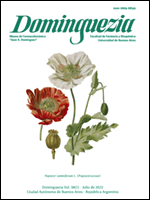Ethnobotanical analysis of the main colonial herbolary of South America South Cone "Materia Médica Misionera" (1710) III: Identification of plants and their applications as vulneraries and against superficial disorders
Keywords:
Vulnerary, medical ethnobotany, medicinal plants, jesuitsAbstract
Many plant entities referred to as vulneraries and for the treatment of superficial disorders that are mentioned in the "Materia Medica Misionera" (M.M.M.), attributed to the Jesuit Pedro de Montenegro dated in 1710, are identified here. Medicinal uses of each one of them are detailed in attention to the historical medical context of reference in which they are registered. The relationships of these results with the current folk medical ethnobotany of the neighboring jesuitic areas are discussed. Botanical identities were estimated on the basis of text and slide descriptions extracted from the primary source, as well as botanical matches of vernacular names obtained from an exhaustive literature search. All the plant entities referred to the category of vulnerary and against superficial disorders in the M.M.M. have been identified here from the botanical-taxonomic point of view (40 of them in this contribution), to which they are assigned 187 ethnobotanical medical data. For the first time, the specific therapeutic indications corresponding to this category are recorded for each taxa, the most important of which are cicatrizers, vulneraries, grain and boils treatment, antifungals and against eruptive diseases. Comparison with current sources shows that part of the data coincides with those registered for Brazilian and Paraguayan folk medicine, while the rest is novel. These results confirm both at the level of specific medicinal uses and the ethnomedical criteria involved, that M.M.M. constitutes the ethnobotanical medical heritage matrix of the folk medicines of the American Southern Cone.



